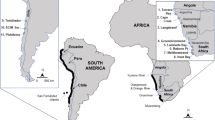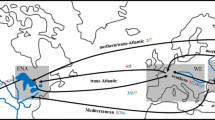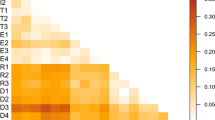Abstract
The quagga mussel Dreissena rostriformis bugensis, native to the Dnieper and the northern Black Sea, has become a major invasive species in both the Volga River and the North American Great Lakes since the early 1990s. Findings in the Netherlands (2006) and Germany (2007) mark the start of its establishment in Western Europe. We investigated the current distribution, time of first arrival and population structure of D. rostriformis bugensis from the rivers Rhine, Main and in the Main-Danube canal in Germany. Two putative sources of the German populations were analysed by genetically comparing these populations to older invasive populations from North America and the southeast Danube. Dreissena rostriformis bugensis was abundant in the Main and in three Rhine harbours, but rare in the actual Rhine river and absent south of the Main-Danube canal. Mussels found in the Rhine harbours were significantly smaller than in the Main. Population genetic analyses found no sign of founder effects and minimal differentiation between German, North American and southeast Danube populations. The genetic data suggest that these invasive populations derive from a common and rapidly expanding source. Based on the non-continuous distribution and shell size differences of Rhine harbour and Main populations, our results indicate that expansion in Germany involved at least two independent settling events, one of which happened before 2005, and most likely was caused by jump dispersal.


Similar content being viewed by others
References
Astanei I, Gosling E, Wilson J, Powell E (2005) Genetic variability and phylogeography of the invasive zebra mussel, Dreissena polymorpha (Pallas). Mol Ecol 14:1655–1666
Benson AJ, Boydstun CP (1995) Invasion of the zebra mussel into the United States. In: Laroe ET, Farris GS, Puckett CE, Doran PD, Mac MJ (eds) Our living resources: a report to the nation on the distribution, abundance, and health of UD plants, animals, and ecosystems. US Department of the Interior, National Biological Service, Washington, DC, pp 445–446
Bially A, MacIsaac HJ (2000) Fouling mussels (Dreissena spp.) colonize soft sediments in lake Erie and facilitate benthic invertebrates. Freshw Biol 43:85–97
Bij de Vaate A, Jazdzewski K, Ketelaars H, Gollasch S, van der Velde G (2002) Geographical patterns in range extension of ponto-caspian macroinvertebrate species in Europe. Can J Fish Aquat Sci 59:1159–1174
Brookfield IFY (1996) A simple method for estimating null allele frequency from heterozygote deficiency. Mol Ecol 5:453–455
Brown JE, Stepien CA (2009) Invasion genetics of the Eurasian round goby in North America: tracing sources and spread patterns. Mol Ecol 18:64–79
Connelly NA, O’Neill CR, Knuth BA, Brown TL (2007) Economic impacts of zebra mussels on drinking water treatment and electric power generation facilities. Environ Manag 40:105–112
Cornuet J-M, Luikart G (1996) Description and power analysis of two tests for detecting recent population bottlenecks from allele frequency data. Genetics 144:2001–2014
Dakin EE, Avise JC (2004) Microsatellite null alleles in parentage analysis. Heredity 93:504–509
Dermott R, Munawar M (1993) Invasion of lake Erie offshore sediments by Dreissena, and its ecological implications. Can J Fish Aquat Sci 50:2298–2304
Excoffier L, Laval G, Schneider S (2005) Arlequin ver. 3.0: an integrated software package for population genetics data analysis. Evol Bioinform Online 1:47–50
Hebert PD, Muncaster BW, Mackie GL (1989) Ecological and genetic studies on Dreissena polymorpha (Pallas): a new mollusc in the great lakes. Can J Fish Aquat Sci 46:1587–1591
ISSG (2008) The invasive species problem. Retrieved from http://www.issg.org/ on 20 Jan 2009
Jarvis P, Dow J, Dermott R, Bonnell R (2000) Zebra (Dreissena polymorpha) and quagga mussel (Dreissena bugensis) distribution and density in lake Erie, 1992–1998. Canadian Technical Report of Fisheries and Aquatic Science Department of Fisheries and Oceans, Canada Centre for Inland Waters, Burlington
Kang M, Wang J, Huang H (2008) Demographic bottlenecks and low gene flow in remnant populations of the critically endangered Berchemiella wilsonoo var. pubipetiolata (Rhamnaceae) inferred from microsatellite markers. Conserv Genet 9:191–199
Karatayev AY, Burlakova LE, Padilla DK (1997) The effects of Dreissena polymorpha (Pallas) invasion on aquatic communities in eastern Europe. J Shellfish Res 16:187–203
Keniry T, Marsden JE (1995) Zebra mussels in southwestern lake Michigan. In: Laroe ET, Farris GS, Puckett CE, Doran PD, Mac MJ (eds) Our living resources: a report to the nation on the distribution, abundance, and health of UD plants, animals, and ecosystems. US Department of the Interior, National Biological Service, Washington, DC, pp 445–448
Kinzelbach R (1992) The main features of the phylogeny and dispersal of the zebra mussel. In: Neumann D, Jenner HA (eds) The zebra mussel Dreissena polymorpha: ecology, biological monitoring and first applications in the water quality management. Gustav Fischer, Stuttgart. Limnol Aktuell 4:4–17
Marsden JE, Spidle A, May B (1995) Genetic similarity among zebra mussel populations within North-America and Europe. Can J Fish Aquat Sci 52:836–847
Martens A, Grabow K, Schoolmann G (2007) Die quagga-muschel Dreissena rostriformis bugensis (Andrusov, 1897) am Oberrhein (Bivalvia: Dreissenidae). Lauterbornia 60:145–152
May B, Marsden JE (1992) Genetic identification and implications of another invasive species of dreissenid mussel in the great Lakes. Can J Fish Aquat Sci 49:1501–1506
Mills EL, Rosenberg G, Spidle AP, Ludyanskiy M, Pligin Y, May B (1996) A review of the biology and ecology of the quagga mussel (Dreissena bugensis), a second species of freshwater dreissenid introduced to North America. Am Zool 36:271–286
Mills EL, Chrisman JR, Baldwin B, Owens RW, O’Gorman R, Howell T, Roseman EF, Raths MK (1999) Changes in the dreissenid community in the lower great lakes with emphasis on southern lake Ontario. J Great Lakes Res 25:187–197
Molloy DP, de Vaate AB, Wilke T, Giamberini L (2007) Discovery of Dreissena rostriformis bugensis (Andrusov 1897) in Western Europe. Biol Invest 9:871–874
Müller JC (2001) Invasion history and genetic population structure of riverine macroinvertebrates. Zoology 104:346–355
Müller JC, Hidde D, Seitz A (2002) Canal construction destroys the barrier between major European invasion lineages of the zebra mussel. Proc R Soc Lond B 269:1139–1142
Orlova MI, Muirhead JR, Antonov PI, Shcherbina GK, Starobogatov YI, Biochino GI, Therriault TW, MacIsaac HJ (2004) Range expansion of quagga mussels Dreissena rostriformis bugensis in the Volga river and Caspian sea basin. Aquat Ecol 38:561–573
Piry S, Alapetite A, Cornuet J-M, Paetkau D, Baudouin L, Estoup A (2004) GENECLASS2: a software for genetic assignment and first-generation migrant detection. J Hered 95:536–539
Pligin Y (1984) Extension of the distribution of Dreissena bugensis. Malacol Rev 17:143–144
Popa OP, Popa LO (2006) The most westward European occurence point for Dreissena bugensis (Andrusov 1897). Malacol Bohemoslov 5:3–5
Raymond M, Rousset F (1995) Genepop (version 1.2)—population genetics software for exact tests and ecumenicism. J Hered 86:248–249
Ricciardi A (2006) Patterns of invasion in the Laurentian great lakes in relation to changes in vector activity. Divers Distrib 12:425–433
Ricciardi A, Whoriskey FG (2004) Exotic species replacement: shifting dominance of dreissenid mussels in the soulanges canal, upper St. Lawrence River, Canada. J N Am Benthol Soc 23:507–514
Ricciardi A, Neves RJ, Rasmussen JB (1998) Impending extinctions of North American freshwater mussels (Unionoida) following the zebra mussel (Dreissena polymorpha) invasion. J Anim Ecol 67:613–619
Rice WR (1989) Analyzing tables of statistical tests. Evolution 43:223–225
Son MO (2007) Native range of zebra mussel and quagga mussel and new data on their invasions within the ponto-caspian region. Aquat Invest 3:174–184
Stepien CA, Tumeo MA (2006) Invasion genetics of ponto-caspian gobies in the Great lakes: a ‘cryptic’ species, absence of founder effects, and comparative risk analysis. Biol Invasions 8:61–78
Stepien CA, Dillon AK, Chandler MD (1998) Genetic identity, phylogeography, and systematics of Ruffe Gymnocephalus in the North American Great Lakes and Eurasia. J Great Lakes Res 24:361–378
Stepien CA, Taylor CD, Dabrowska KA (2002) Genetic variability and phylogeographical patterns of a nonindigenous species invasion: a comparison of exotic vs. native zebra and quagga mussel populations. J Evol Biol 15:314–328
Stepien CA, Brown JE, Neilson ME, Tumeo MA (2005) Genetic diversity of invasive species in the Great lakes versus their Eurasian source populations: insights for risk analysis. Risk Anal 25:1043–1060
Therriault TW, Orlova MI, Docker MF, MacIsaac HJ, Heath DD (2005) Invasion genetics of a freshwater mussel (Dreissena rostriformis bugensis) in eastern Europe: high gene flow and multiple introductions. Heredity 95:16–23
Thienemann A (1950) Verbreitungsgeschichte der Süßwassertierwelt Europas. In: Thienemann A (ed) Die Binnengewässer. Schweizerbart’sche Verlag, Stuttgart
van der Velde G, Platvoet D (2007) Quagga mussels Dreissena rostriformis bugensis (Andrusov, 1897) in the main river (Germany). Aquat Invest 3:261–264
van Oosterhout C, Hutchinson WF, Wills DPM, Shipley P (2004) MICRO-CHECKER: software for identifying and correcting genotyping errors in microsatellite data. Mol Ecol Notes 4:535–538
Weir BS, Cockerham CC (1984) Estimating F-statistics for the analysis of population structure. Evolution 38:1358–1370
Wilson AB, Boulding EG, Naish KA (1999) Characterization of tri- and tetranucleotide microsatellite loci in the invasive mollusc Dreissena bugensis. Mol Ecol 8:692–693
Zayed A, Whitfield CW (2008) A genome-wide signature of positive selection in ancient and recent invasive expansions of the honey bee Apis mellifera. PNAS 105:3421–3426
Zhulidov AV, Pavlov DF, Nalepa TF, Scherbina GH, Zhulidov DA, Gurtovaya TY (2004) Relative distributions of Dreissena bugensis and Dreissena polymorpha in the lower Don river system, Russia. Intern Rev Hydrobiol 89:326–333
Zhulidov AV, Zhulidov DA, Pavlov DF, Nalepa TF, Gurtovaya TY (2005) Expansion of the invasive bivalve mollusc Dreissena bugensis (quagga mussel) in the Don and volga river basins: revisions based on archived specimens. Ecohydrol Hydrobiol 5:127–133
Zhulidov AV, Nalepa TF, Kozhara AV, Zhulidov DA, Gurtovaya TY (2006) Recent trends in relative abundance of two dreissenid species, Dreissena polymorpha and Dreissena bugensis in the lower Don river system, Russia. Arch Hydrobiol 165:209–220
Acknowledgments
We thank Daniel P. Molloy and Andreas Martens for providing reference samples from Lake Ontario and Rhine harbours, respectively. We thank Godila Thomas, Dennis Hidde and members of the Joint Danube Survey for collecting samples from the Main, Rhine and Danube Rivers. We thank Neil Linville for correcting the English, and two anonymous reviewers for their help in improving the manuscript.
Author information
Authors and Affiliations
Corresponding author
Rights and permissions
About this article
Cite this article
Imo, M., Seitz, A. & Johannesen, J. Distribution and invasion genetics of the quagga mussel (Dreissena rostriformis bugensis) in German rivers. Aquat Ecol 44, 731–740 (2010). https://doi.org/10.1007/s10452-009-9311-2
Received:
Accepted:
Published:
Issue Date:
DOI: https://doi.org/10.1007/s10452-009-9311-2




